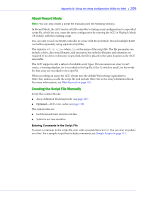Adaptec 3405 User Guide - Page 106
About Record Mode, Creating the Script File Manually, Entering Comments in the Script File
 |
UPC - 760884155028
View all Adaptec 3405 manuals
Add to My Manuals
Save this manual to your list of manuals |
Page 106 highlights
Appendix D: Using the Array Configuration Utility for DOS ● 106 About Record Mode Note: You can also create a script file manually (see the following section). In Record Mode, the ACU writes a RAID controller's existing array configuration to a specified script file, which lets you create the same configuration by running the ACU in Playback Mode (/P switch) with the resulting script. You can only record one RAID controller at a time with Record Mode. Record multiple RAID controllers separately using separate script files. The syntax is ACU /R where file is the name of the script file. The file parameter can include a drive, directory, filename, and extension, but only the filename and extension are required. If no drive or directory is specified, the file is placed in the same location as the ACU executable. The ACU supports only a subset of available array types. If it encounters an array it can't create, a warning displays (or is recorded in the log file, if the /L switch is used); no keywords for that array are recorded in its script file. When recording an array, the ACU always uses the default Wait setting (equivalent to Wait=Yes) unless you edit the script file and include Wait=No in the array's definition block. For more information, see Wait Keyword on page 110. Creating the Script File Manually Script files contain blocks: ● Array definition block keywords (see page 107) ● Optional-ACU error codes (see page 110) The syntax rules are: ● Each keyword must start its own line. ● Syntax is not case sensitive. Entering Comments in the Script File To enter a comment in the script file, start with a pound character (#). You can start anywhere on a line. For a sample script that includes comments, see Sample Scripts on page 111.















